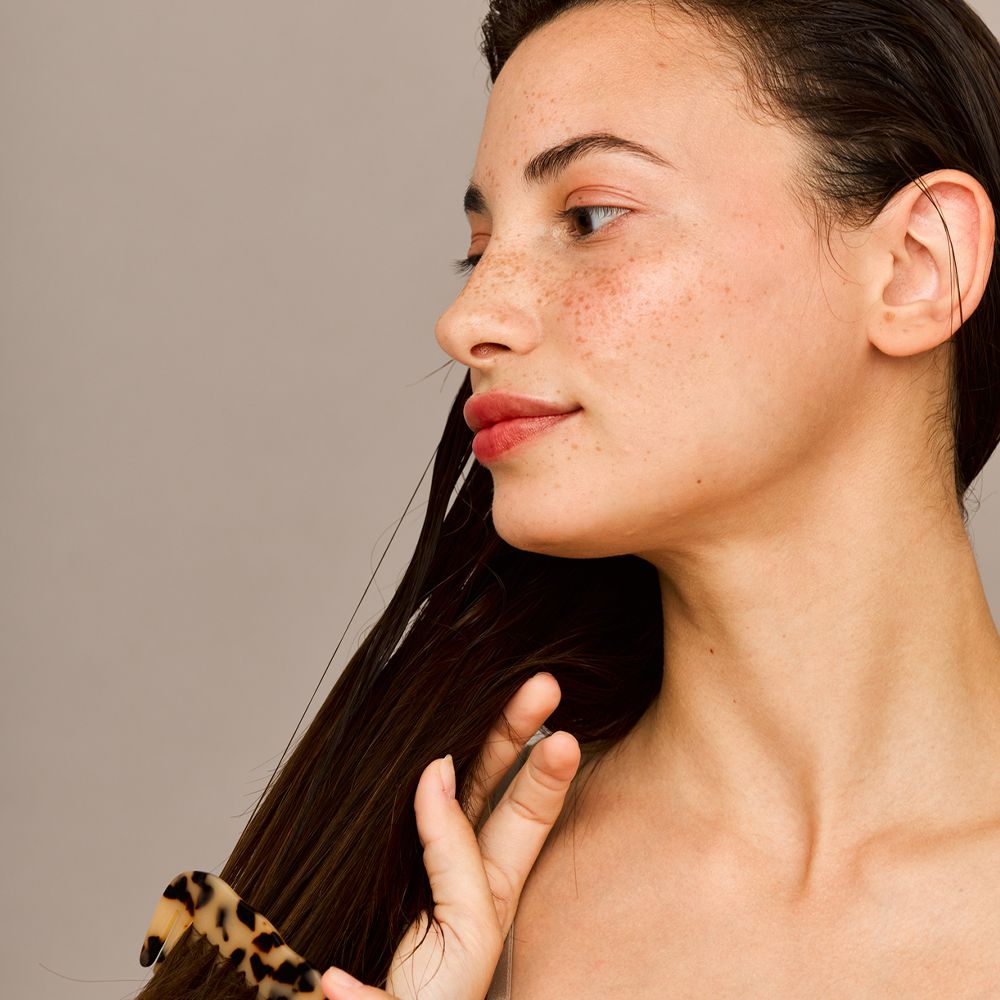You’ve mastered identifying your skin type and balancing its oil levels and dehydration, but did you know your scalp and hair are just as complex? Like your skin, hair can also be categorized as combination, with oily and dry zones occurring because of daily wear and tear from the environment, chemical treatments, and daily styling.
According to Kasper Heemskerk, the international education manager of Balmain Hair Couture, combination hair has oily roots and dry lengths. “People with combination hair overproduce oils on the scalp, and the oils do not get distributed through the hair shaft to the ends. So, we see hair with oily scalps and dry, brittle ends,” Heemskerk explains.
Ahead, we spoke to a trichologist, dermatologist, and industry hair experts to help you better identify the signs of combination hair and how to take the guesswork out of your routines for better hair days.
Meet the Expert
- Kasper Heemskerk is the international education manager of Balmain Hair Couture.
- Anabel Kingsley is the President and Head Trichologist at Philip Kingsley.
- Gretchen Fries is a BosleyMD-certified trichologist.
- Dr. Elyse Love, a board-certified dermatologist based in New York City.
What Causes Combination Hair?
Multiple factors cause combination hair with your scalp type playing the most critical role. Your scalp is one of the most sebaceous areas of skin on your body, and everyone’s is unique. “Some scalps are naturally more sensitive and reactive than others, and one’s scalp condition can fluctuate depending on the weather, seasons, diet, menstrual cycle, and stress levels,” explains Anabel Kingsley, head trichologist of Philip Kingsley. Ultimately, anyone can have combination hair despite their hair texture.
What Hair Types Are Most Likely to be Considered Combination?
Fine, thick, curly, and straight hair can all be classified as combination, but it’s the most prevalent in fine, long hair since they are most likely to have oily scalps. “People with fine hair have more oil glands on their scalp than coarser hair types, so the roots are also likely to get oily. The longer your hair is, the more likely your ends will be dry because they are older and more weathered,” says Kingsley.
According to Gretchen Fries, BosleyMD-certified trichologist, curly hair textures are also susceptible to being combination in nature. “Those with oily scalps and curly, long hair produce sebum which can’t travel down the curly hair shaft. As a result, this hair type is usually left with a greasy scalp and dehydrated ends,” she explains.
How to Care for Combination Hair
Stop overwashing
When it comes to combination hair, experts say its better to stay away from overwashing, which may cause the scalp to create more sebum by overproducing oils since their being stripped away. “Over-washing can leave you with an oily scalp and dry lengths. Don’t wash more than once a day,” Kingsley says.
Finding balance is the goal when dealing with combination hair. Kingsley recommends that people with thin, straight or wavy combination hair wash their hair once a day—like the skin on your face, which benefits from daily cleansing. Kingsley says to use a shampoo suitable for your hair texture and treat dry ends with an intensive pre-shampoo conditioning treatment, like the Philip Kingsley Elasticizer Pre-Shampoo Treatment ($30) which hydrates strands and restores elasticity.
For curly hair textures, you might shampoo less frequently, or prefer how your hair looks between shampoos. In this case, Kingsley recommends focusing on your scalp health when wash day rolls around. “Don’t leave more than three days between cleansing your scalp,” she says.
Pick the right shampoo and conditioner
Curating a routine for your combination hair doesn’t have to be complicated. The main goal should be to cleanse oily areas while hydrating drier parts. The best way to achieve this is to pick a proper shampoo and conditioner. If your scalp is oily, stay away from over-hydrating hair products because they can increase product buildup. Dry scalps should also avoid heavy formulas that’ll coat the ends and leave them greasy.
Instead, for an oily scalp and dry ends, Heemskerk suggests a light shampoo and hydrating conditioner only on the lengths and ends. You can reverse that approach when dealing with dry scalp and balanced ends, by using a hydrating shampoo to treat the scalp and a lightweight conditioner on lengths and ends. Some clarifying shampoos might work wonders for oily scalps, but might be too drying for combination scalps.
In this case, Dr. Elyse Love, a board-certified dermatologist, says to look for scalp products that focus on gentle cleansing. “Look for specific scalp shampoos that’ll help focus on decongesting and soothing the scalp while also removing buildup from the hair strands,” she says. If you are experiencing persistent scalp concerns and discomfort, you should talk to your board-certified dermatologist.
If you have an itchy scalp or dandruff, we love the Dove DermaCare Scalp Coconut and Hydration Anti-Dandruff Shampoo ($5), which has pyrithione zinc to soothe and calm irritated scalps while coconut restores moisture and offers natural antimicrobial benefits.
Don’t forget to brush
Combination hair typically needs moisture from mid-lengths to ends, and Dr. Love says combing your conditioner through wet hair is the easiest way to distribute hydration that won’t weigh down your hair. “Straight hair can brush in the morning to help redistribute oils, but curly hair should never dry brush as this causes further breakage and damage,” Dr. Love explains.
Invest in a Scalp Scrub
Scalp scrubs may seem like a buzzy new hair category, but a good one can be largely beneficial to any hair routine. Kingsley recommends using an exfoliator to soothe scalp, buff dead skin cells, and target any imbalances. “Scalp scrubs are especially beneficial if you are shampooing less than every other day,” shares Kingsley. Look for scalp treatments like the Philip Kingsley Flaky Scalp Mask, which contains exfoliating salicylic acid, anti-microbial piroctone olamine, hydrating hyaluronic acid and shea butter or for severely oily and clogged scalps, use a scrub like BosleyMD Rejuvenating Scalp Scrub which features bamboo, charcoal, and caffeine to absorb excess oil, remove product buildup and prevent further inflammation.
Use hot tools sparingly
If you have combination hair, you should use hot tools sparingly to avoid stripping your scalp and ends. Kingsley also recommends never using hot tools without a protective spray. “Don’t use hot tools every time you wash your hair because the daily shampooing followed by heat styling further exacerbates combination hair by drying and weakening your mid-lengths and ends,” Kingsley says.
Final Takeaway
Similar to combination skin, combination hair is completely manageable once identified. The primary solution is to create a routine with the proper products and applications to balance care between the scalp and strands, which should work to keep your hair looking and feeling healthy. However, if following an edited routine still leaves your hair feeling imbalanced or if you notice the development or worsening of a hair (or scalp condition), talk to your dermatologist or trichologist to see if it’s more than combination strands at play.










